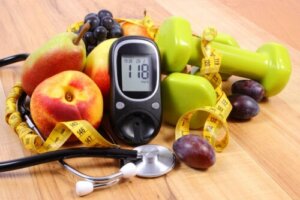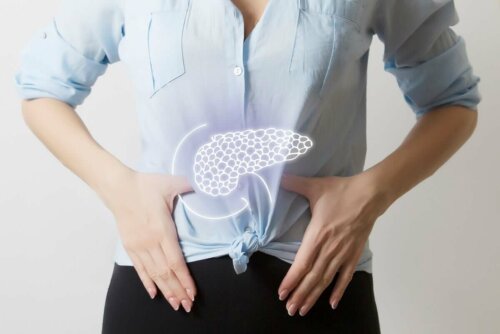Characteristics of Hyperinsulinemia and Treatment

Metabolic diseases manifest through various signs and symptoms and an increase in insulin values is one of them. In fact, it’s commonly associated with type 2 diabetes mellitus. Hyperinsulinemia is serious although its treatment is quite simple. Today’s article will discuss it in detail.
Firstly, let’s go over the functions of insulin. It’s the hormone in charge of regulating glucose levels in the blood. Thus, it promotes the entrance of sugar to the muscles and other peripheral tissues.
Hyperinsulinemia
This is a well-known condition but it’s difficult to give a precise definition of what it is. Some describe it as an excess of insulin in the blood. However, it’s hard to determine when it’s present as there are no reference values.
In most cases, doctors diagnose it when doing tests for other diseases. They do so by comparing glucose and insulin levels in the blood during a period of fasting.
The symptoms of this hormonal alteration aren’t precise but high insulin levels, hypoglycemia, and low blood glucose are common. However, hypoglycemia isn’t specific and can be a symptom of many pathologies.
The following stand out from among other symptoms that people with hyperinsulinemia may present:
- Sugar and carb cravings
- Weight gain and difficulty losing it
- Fatigue and lack of motivation
- Lack of concentration
- Increased appetite

Treatment of hyperinsulinemia
The treatment of hyperinsulinemia is very similar to that of type 2 diabetes mellitus. The medical approach for both focuses on a patient’s change in lifestyle. In general, the goal is for them to adopt healthier daily habits.
Changes in the diet
The first thing a physician will indicate to a person with hyperinsulinemia will be a healthy, low-calorie weight loss diet. In fact, researchers observed that reducing 5 to 10% of body weight is enough to improve various metabolic conditions.
In this respect, they also recommend a significant decrease in the consumption of carbohydrates to reduce blood glucose. At the same time, they must restrict the consumption of saturated and trans fats. Ideally, they should maintain a daily intake of less than 7% of saturated fats and less than 1% of trans fats.
In addition, they must also increase the intake of foods rich in fiber such as grains, cereals, fruit, and vegetables. In addition, they must also increase the consumption of monosaturated and omega 3 fats. The daily intake of proteins should be around 20%.
Read about The Relationship between Obesity and the Endocrine Glands
Exercise and weight loss
This part is about complementing a healthy diet in order to promote weight loss. Changes in diet and a slight weight loss reduce the chances of suffering from type 2 diabetes mellitus after having hyperinsulinemia by 58%.
In this respect, doing aerobic exercise for 30 or 40 minutes, 4 times a week, improves your quality of life. In addition, it’s important not to take more than 2 days off between routines. This is mainly to obtain better results.
In addition, begin with light exercises and increase the level of difficulty gradually as your physical condition improves if you’ve had a sedentary lifestyle when you begin.
Stress reduction
Psychological stress affects the body and can lead to an excessive release of glucose into the bloodstream and consequently, an extra secretion of insulin. Chronic stress promotes hyperinsulinemia.
Thus, reducing stress is part of the treatment of hyperinsulinemia. This is why professionals often recommend leading a less hectic life through various relaxation techniques.
Pharmacological and surgical treatment for hyperinsulinemia
There are times when it takes more than lifestyle changes to reverse the process of hyperinsulinemia. In these cases, a patient may require pharmacological treatment, the same that should adapt to their individual needs.
These are some of the drugs a doctor may prescribe:
- Insulin secretion inhibitors
- Dextrose or glucose release stimulants
- Inhibitors of the effect of insulin
There are times when hyperinsulinemia may be due to an insulin-producing pancreatic tumor. These cases require a slightly more aggressive approach even after a pancreatectomy.

Hyperinsulinemia treatment and lifestyle
As you can see, the diagnosis of hyperinsulinemia is complex and often goes unnoticed. However, the treatment protocol is easy to apply. In most cases, a radical change towards a healthier lifestyle will considerably improve the situation.
Finally, any person with hyperinsulinemia must improve their diet, increase physical activity, and reduce stress. This is because all of this will lower blood sugar levels and, consequently, decrease insulin secretion. Thanks for reading.
All cited sources were thoroughly reviewed by our team to ensure their quality, reliability, currency, and validity. The bibliography of this article was considered reliable and of academic or scientific accuracy.
- Madonna R, De Caterina R. Aterogénesis y diabetes: resistencia a la insulina e hiperinsulinemia. Revista Española de Cardiología. 2012;65(4):309-313.
- Fung J, Berger A. Hyperinsulinemia and Insulin Resistance: Scope of the Problem. Journal of Insulin Resistance. 2016;1(1).
- Perez de Inestrosa B, Vallecillos Perez M, Torres A, Molina Perez M. Obesidad e hiperinsulinismo. Medicina General y de la Familia. 2014;3(1):5-7.
- Tovar, Alejandro Pinzón, and Samuel Yucumá Gutiérrez. “Hiperinsulinismo endógeno diagnosticado como epilepsia.” Revista Colombiana de Endocrinología, Diabetes & Metabolismo 3.1 (2017): 51-55.
- Turcios Tristá, Silvia Elena, et al. “Hipoglucemia por hiperinsulinismo endógeno.” Revista Cubana de Endocrinología 30.2 (2019).
- Cabezas-Zábala, Claudia Constanza, Blanca Cecilia Hernández-Torres, and Melier Vargas-Zárate. “Aceites y grasas: efectos en la salud y regulación mundial.” Revista de la Facultad de Medicina 64.4 (2016): 761-768.
- Tárraga López, Bárbara María. “Revisión de los efectos de la dieta cetogénica sobre enfermedades derivadas de la hiperinsulinemia y de la inflamación crónica de bajo grado.” (2019).
- Rojas, Joselyn, et al. “Insulinorresistencia e hiperinsulinemia como factores de riesgo para enfermedad cardiovascular.” Archivos Venezolanos de Farmacología y Terapéutica 27.1 (2008): 30-40.
- Burgos SJ, Luis. “Tumores neuroendocrinos del páncreas.” Revista médica de Chile 132.5 (2004): 627-634.
- DEL SÍNDROME, G. D. E. “Consenso Mexicano sobre el tratamiento integral del síndrome metabólico.” Rev Mex Cardiol 13.1 (2002): 4-30.
This text is provided for informational purposes only and does not replace consultation with a professional. If in doubt, consult your specialist.








